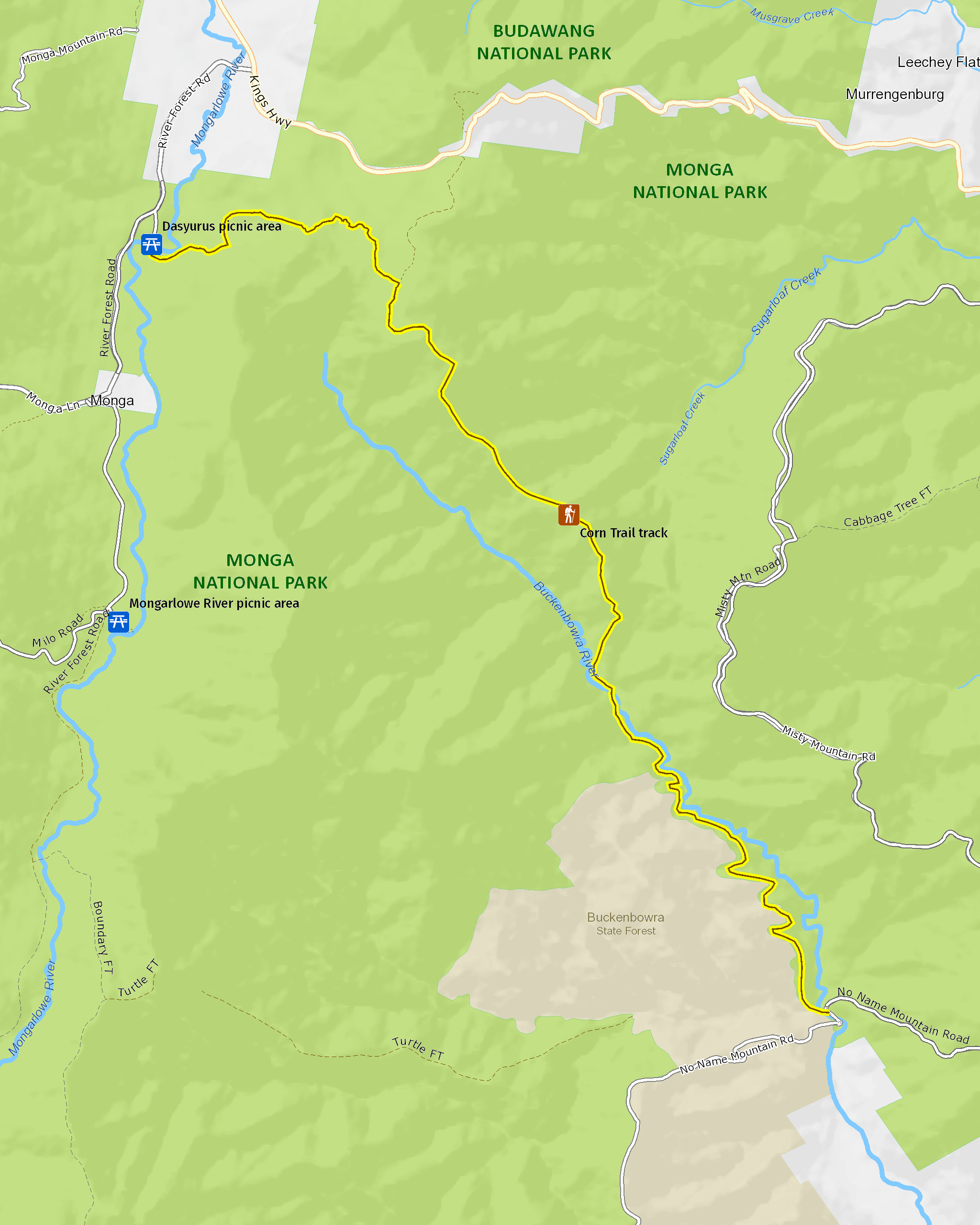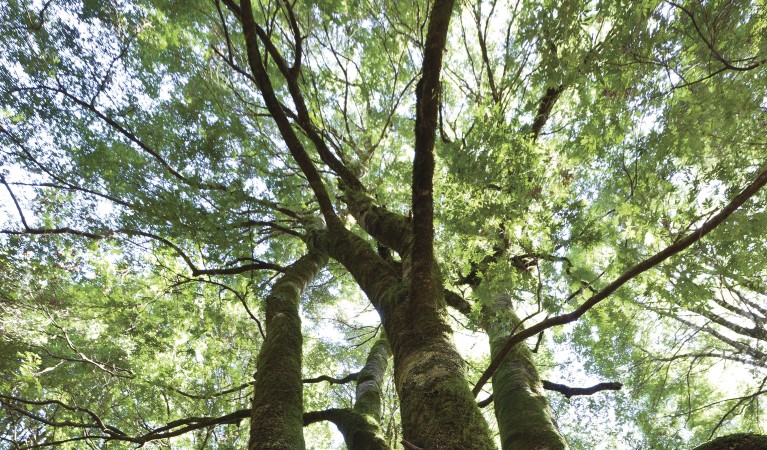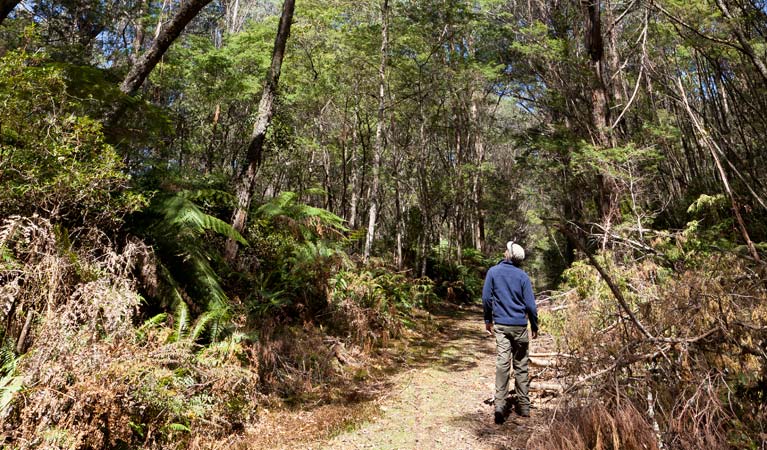Corn Trail walking track
Monga National Park
Overview
Corn Trail walking track is a historic trail for hikers and horse riders to traverse a wide variety of landscapes and follow in the footsteps of the past.
- Where
- Monga National Park in South Coast, Country NSW
- Distance
- 16km one-way
- Time suggested
- 6hrs - 6hrs 30min
- Grade
- Grade 4
- Trip Intention Form
-
It's a good idea to let someone know where you're going. Fill in a trip intention form to send important details about your trip to your emergency contact.
- What to
bring - Drinking water, first aid kit, personal locator beacon, topographic map, compass, hat, sunscreen, sturdy shoes, torch, insect repellent, clothes for all weather conditions
- Please note
- This is a remote area and there's is limited mobile reception. Please bring a Personal Locator Beacon (PLB)
- Topographic maps are recommend: take 1:25 000 topographic maps for Monga and Araluen
- Weather in this area can be extreme and unpredictable, so ensure you’re well-prepared for your visit. This area can experience wind storms and walkers may encounter fallen trees over parts of the track.
Take a journey back in time and follow a route that has been used for thousands of years. Popular today with bushwalkers and horse riding groups, Corn Trail walking track was originally used by Aboriginal people on their seasonal travels between the coast and the tablelands, then later by European settlers on pack horses carrying supplies.
This historic trail takes you downhill from high mountain ridges to deep rainforest-filled valleys. You'll cross the gently flowing Mongarlowe and Buckenbowra Rivers, wander through warm temperate rainforest and walk through eucalypt forests. You’ll also catch glimpses of Mount Budawang and the sandstone peaks of Pigeon House and Castle Mountain further north.
It’s a difficult walk, so you’ll need to come prepared, but the scenery is worth it.
It is easier to do this walk downhill from the Dasyurus Picnic Area to the Lower Corn Trail car park, which allows you to do a car shuffle. You can access Lower Corn Trail car park via the Misty Mountain and No Name Mountain Roads. It's a 40 minute, one-way drive from Kings Highway, but well worth to have a vehicle and supplies waiting for you at the end of a long day.
Map

Map legend

Local alerts
For the latest updates on fires, closures and other alerts in this area, see https://www.nationalparks.nsw.gov.au/things-to-do/walking-tracks/corn-trail-walking-track/local-alerts
Park info
- in Monga National Park in the South Coast and Country NSW regions
Monga is always open but may have to close at times due to poor weather or fire danger.
Visitor info
All the practical information you need to know about Corn Trail walking track.
Maps and downloads
Learn more
Corn Trail walking track is in Monga National Park. Here are just some of the reasons why this park is special:
A glimpse of trading history

Monga National Park is significant for its natural wonders and its historic heritage. Corn Trail walking track, which is today enjoyed by bushwalkers and horse riders, was the first trade route between the Buckenbowra Valley farmlands near the coast and the early European settlements on the tablelands near Braidwood. Further settlement came to the area in the 1840s, with the establishment of the timber trade and gold mining. The sawmill at Monga provided timber for Braidwood and the establishment of Canberra in the 1900s, with logging continuing in the area until 1987.
- Corn Trail walking track Corn Trail walking track is a historic trail for hikers and horse riders to traverse a wide variety of landscapes and follow in the footsteps of the past.
Aboriginal culture

For over 14,000 years, the Yuin and Walbunja people have lived around the valleys of Clyde, Deua and Buckenbowra rivers. Walkers and horse riders can walk in their footsteps on Corn Trail walking track, which was one of the trails used by Aboriginal people to travel between the coast and the tablelands. There are many Aboriginal cultural sites in the park where stone artefacts, fire beacons and old campsites have been found.
Unique plantlife

Many of the plants you'll find in the cool, temperate rainforests of Monga are millions of years in the making. Related to the plants from the super continent Gondwana, they present a unique window to the past. The plumwood trees and soft tree ferns you see in the park are closely related to pollen fossils found in Antarctica. Some plumwood trees here have widths of up to 4m and are thought to be thousands of years old. Wander along the banks of Mongarlowe River and you'll also see the distinctive bright red flowers of the Monga waratah.
- Dasyurus picnic area Dasyurus picnic area is a tranquil spot to stop on your drive to the coast from Canberra or a great day trip from Batemans Bay or Braidwood.
- Mongarlowe River picnic area Under the shade of eucalypt forest, this sheltered picnic site is an ideal place to start exploring Monga's rich habitats with easy strolls, swimming, and birdwatching.
Plants and animals protected in this park
Animals
-

Short-beaked echidna (Tachyglossus aculeatus)
One of only 2 egg-laying mammals in the world, the short-beaked echidna is one of the most widespread of Australian native animals. Covered in spines, or quills, they’re equipped with a keen sense of smell and a tube-like snout which they use to break apart termite mounds in search of ants.
-

Platypus (Ornithorhynchus anatinus)
One of the most fascinating and unusual Australian animals, the duck-billed platypus, along with the echidna, are the only known monotremes, or egg-laying mammals, in existence. The platypus is generally found in permanent river systems and lakes in southern and eastern NSW and east and west of the Great Dividing Range.
-

Grey-headed flying-fox (Pteropus poliocephalus)
The grey-headed flying fox is Australia's largest native bat, with a wingspan up to 1m. This threatened species travels up and down south-eastern Australia and plays a vital role in pollinating plants and spreading seeds in our native forests.
-

Spotted-tailed quoll (Dasyurus maculatus)
The spotted-tailed quoll is the largest remaining carnivorous marsupial on the Australian mainland. It’s protected as a vulnerable species in NSW.
Plants
-

Waratah (Telopea speciosissima)
The beautiful waratah is not only the NSW floral emblem, it's also one of the best-known Australian native plants. This iconic Australian bush flower can be found on sandstone ridges around Sydney, in nearby mountain ranges and on the NSW South Coast. The waratah has a vibrant crimson flowerhead, measuring up to 15cm across, and blossoms in spring.

